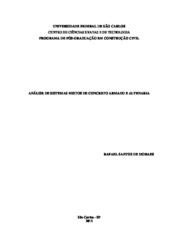| dc.contributor.author | Moraes, Rafael Santos de | |
| dc.date.accessioned | 2016-06-02T20:09:15Z | |
| dc.date.available | 2012-04-16 | |
| dc.date.available | 2016-06-02T20:09:15Z | |
| dc.date.issued | 2012-02-28 | |
| dc.identifier.citation | MORAES, Rafael Santos de. Analysis of composite systems of reinforced concrete and masonry. 2012. 175 f. Dissertação (Mestrado em Ciências Exatas e da Terra) - Universidade Federal de São Carlos, São Carlos, 2012. | por |
| dc.identifier.uri | https://repositorio.ufscar.br/handle/ufscar/4668 | |
| dc.description.abstract | This study has the aim to analyze, from numerical analysis in finite elements, the behavior of masonry walls of bricks and closing blocks together with structural elements of reinforced concrete, in situations in which masonry and concrete collaborate in the support of the building. The analysis were made based on the diagram of tensions, where it was possible to observe the places with concentration of tensions and their form of distribution, and the parameters with influence on the behavior of the structure. On this analysis, several parameters involved in the composite systems of reinforced concrete and masonry were studied: the modulus of longitudinal deformation of the masonry; the presence and dimension of cracks, lintels and sills, beams and pillars; and models with ideal ties and where the walls join. Besides this, preliminary design of the concrete structure and masonry was carried out. The results of the analysis indicated that the presence of concrete elements together with the masonry results in a more uniform distribution of the tensions, besides having been observed a reduction of 50% in the compression tensions at the bottom of the wall for the model with concrete pillars. It was also verified that in the complete model, with pillars and beams, the beam presents a different behavior from a reticulated structure, indicating that the wall ends up serving it as a distributed support. In the preliminary design, it was noted that, without pillars and beam, the required resistance of the prism is compatible only for structural components. But in the case of beam, besides observing the difference among the models of calculation used and the real behavior of the structure, this element may not present the resistance and/or necessary security for the hypothesis of simply supported beam for the conditions that were admitted here. Regarding this study, it is important to emphasize that there is no intention of defending this type of structure, but rather analyse how it behaves before the actions. | eng |
| dc.description.sponsorship | Financiadora de Estudos e Projetos | |
| dc.format | application/pdf | por |
| dc.language | por | por |
| dc.publisher | Universidade Federal de São Carlos | por |
| dc.rights | Acesso Aberto | por |
| dc.subject | Alvenaria | por |
| dc.subject | Análise numérica | por |
| dc.subject | Dimensionamento | por |
| dc.subject | Construção civil | por |
| dc.subject | Masonry | eng |
| dc.subject | Numerical analysis | eng |
| dc.subject | Right sizing | eng |
| dc.title | Análise de sistemas mistos de concreto armado e alvenaria | por |
| dc.title.alternative | Analysis of composite systems of reinforced concrete and masonry | eng |
| dc.type | Dissertação | por |
| dc.contributor.advisor1 | Furlan Júnior, Sydney | |
| dc.contributor.advisor1Lattes | http://genos.cnpq.br:12010/dwlattes/owa/prc_imp_cv_int?f_cod=K4784209U3 | por |
| dc.description.resumo | Este estudo tem como objetivo analisar, a partir de análises numéricas em elementos finitos, o comportamento de paredes de alvenaria de tijolos e blocos de vedação em conjunto com elementos estruturais de concreto armado, em situações em que alvenaria e concreto colaboram no suporte da edificação. As análises foram feitas com base em diagramas de tensões, onde foi possível observar os locais com concentração de tensões e sua forma de distribuição, e os parâmetros com influência no comportamento da estrutura. Nessas análises foram estudados vários parâmetros envolvidos nos sistemas mistos de concreto armado e alvenaria: o módulo de deformação longitudinal da alvenaria; a presença e dimensões de aberturas, vergas e contravergas, vigas e pilares; e modelos com vínculos ideais e encontro de paredes. Além disso, foi feito o pré-dimensionamento da estrutura de concreto e alvenaria. Os resultados das análises indicaram que a presença de elementos de concreto junto com a alvenaria resulta em uma distribuição mais uniforme das tensões, além de ter sido constatada uma redução de 50% nas tensões de compressão na base da parede para o modelo com pilares de concreto. Verificou-se também que no modelo completo, com pilares e viga, a viga apresenta um comportamento diferente de uma estrutura reticulada, indicando que a parede acaba lhe servindo como um apoio distribuído. No pré-dimensionamento, verificou-se que, na ausência de pilares e viga, a resistência requerida de prisma é compatível apenas para componentes estruturais. Já no caso da viga, além de se constatar a diferença entre os modelos de cálculo usados e o comportamento real da estrutura, esse elemento pode não apresentar a resistência e/ou segurança necessária para a hipótese de viga biapoiada para as condições que aqui foram admitidas. Sobre este estudo, é importante destacar que não se tem a pretensão de defender esse tipo de estrutura, e sim analisar como ela se comporta frente às ações. | por |
| dc.publisher.country | BR | por |
| dc.publisher.initials | UFSCar | por |
| dc.publisher.program | Programa de Pós-Graduação em Engenharia Civil - PPGECiv | por |
| dc.subject.cnpq | ENGENHARIAS::ENGENHARIA CIVIL::CONSTRUCAO CIVIL | por |
| dc.contributor.authorlattes | http://lattes.cnpq.br/5825409784858184 | por |
